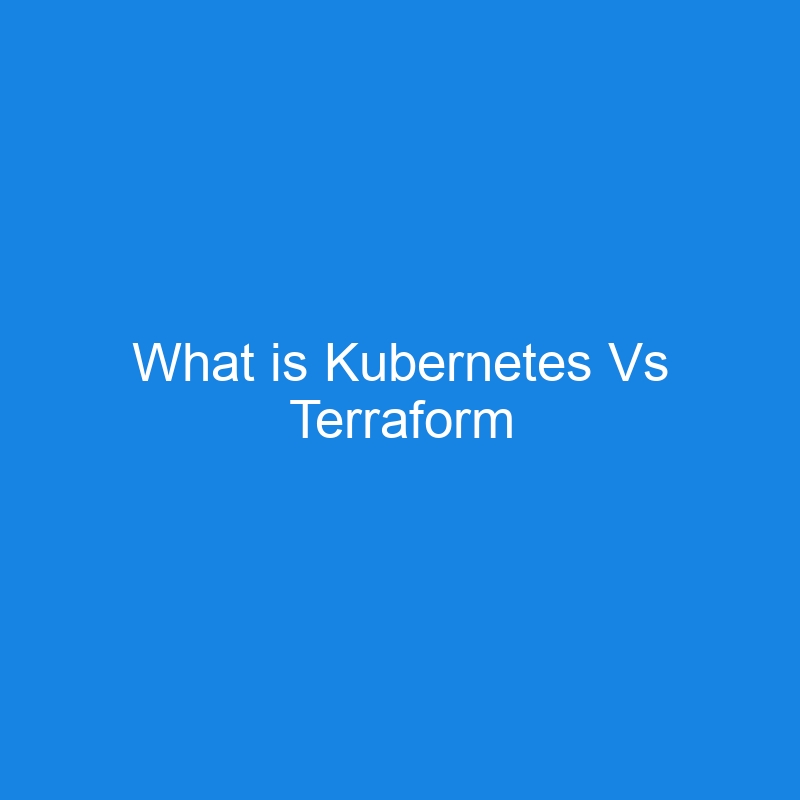In the ever-evolving landscape of modern software development, Kubernetes and Terraform stand out as two essential tools for managing infrastructure and applications. While both are critical for modern DevOps and cloud-native ecosystems, they serve different purposes and operate in distinct domains. Understanding the differences between Kubernetes and Terraform is key to leveraging them effectively. Let’s dive deeper into what these tools are and how they compare.
Kubernetes: The Orchestrator for Containers
Kubernetes, often abbreviated as K8s, is an open-source container orchestration platform designed to automate the deployment, scaling, and management of containerized applications. Originally developed by Google and now maintained by the Cloud Native Computing Foundation (CNCF), Kubernetes has become the de facto standard for managing containerized workloads.
Key Features of Kubernetes:
-
Automated Scaling: Kubernetes can scale applications horizontally by adding or removing containers based on demand.
-
Self-Healing: Automatically restarts failed containers, replaces nodes, and reschedules pods to maintain application health.
-
Service Discovery and Load Balancing: Provides built-in mechanisms to route traffic to the correct container instances.
-
Declarative Configuration: Applications and their configurations are defined in YAML or JSON files, ensuring consistent and repeatable deployments.
-
Multi-Cloud and Hybrid Support: Kubernetes can run on any cloud platform or on-premises, making it highly portable.
Use Case:
Kubernetes is ideal for managing microservices architectures and ensuring seamless scalability and reliability for containerized applications.
Terraform: The Infrastructure as Code Pioneer
Terraform, developed by HashiCorp, is an open-source Infrastructure as Code (IaC) tool that allows you to define and provision infrastructure using a high-level configuration language. Unlike Kubernetes, which focuses on application orchestration, Terraform is designed for infrastructure management, enabling you to automate the creation and management of servers, storage, networking, and more.
Key Features of Terraform:
-
Multi-Cloud Support: Works with various providers like AWS, Azure, GCP, and even on-premises solutions.
-
Declarative Syntax: Uses the HashiCorp Configuration Language (HCL) to define infrastructure resources in a readable, reusable format.
-
State Management: Maintains a state file to track the current infrastructure configuration and ensures idempotent deployments.
-
Dependency Management: Automatically determines the order of operations based on resource dependencies.
-
Modular Architecture: Allows the creation of reusable modules for scalable and consistent infrastructure.
Use Case:
Terraform is best suited for provisioning and managing infrastructure at scale, whether it’s setting up cloud environments, networking, or virtual machines.
Kubernetes vs Terraform: A Side-by-Side Comparison
While Kubernetes and Terraform serve distinct purposes, they can work together to provide a seamless DevOps experience. For example, you might use Terraform to provision the infrastructure needed for your Kubernetes cluster and then leverage Kubernetes to manage and deploy your applications on that infrastructure.
Example Workflow:
Use Terraform to provision a cloud environment, set up networking, and create the necessary virtual machines or managed Kubernetes service (e.g., Amazon EKS, Google GKE).
Deploy Kubernetes to orchestrate containerized applications within the infrastructure set up by Terraform.
By combining these tools, organizations can achieve a robust, scalable, and automated infrastructure and application management workflow.
Conclusion
Kubernetes and Terraform are both indispensable tools in the modern DevOps toolkit. Kubernetes excels at managing containerized applications, while Terraform shines in provisioning and managing infrastructure. Understanding their unique roles and how they can complement each other is essential for building efficient, scalable, and resilient systems. Whether you are deploying microservices or managing complex cloud environments, these tools can help you achieve your goals with precision and automation.



